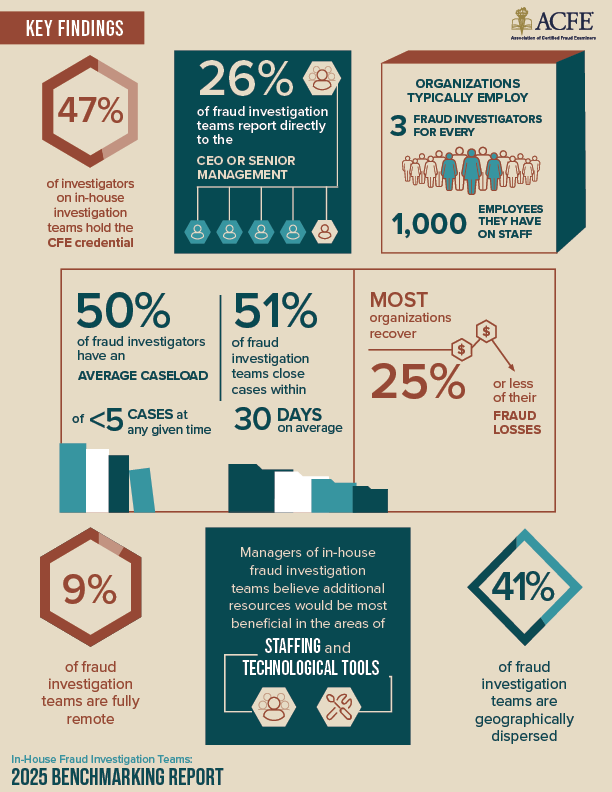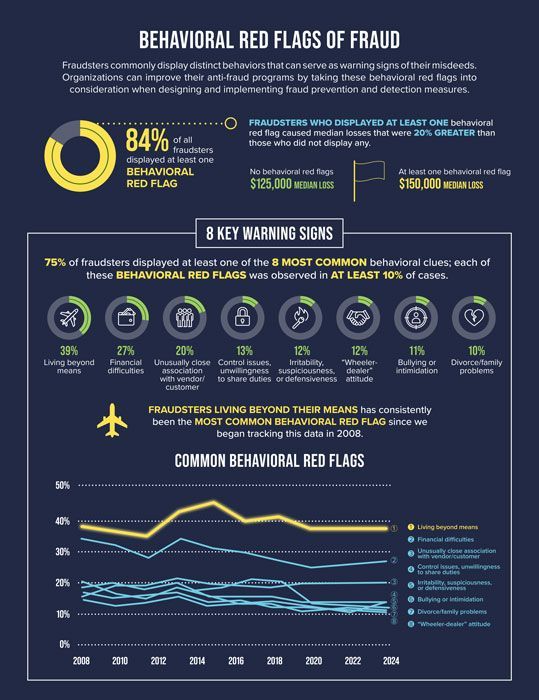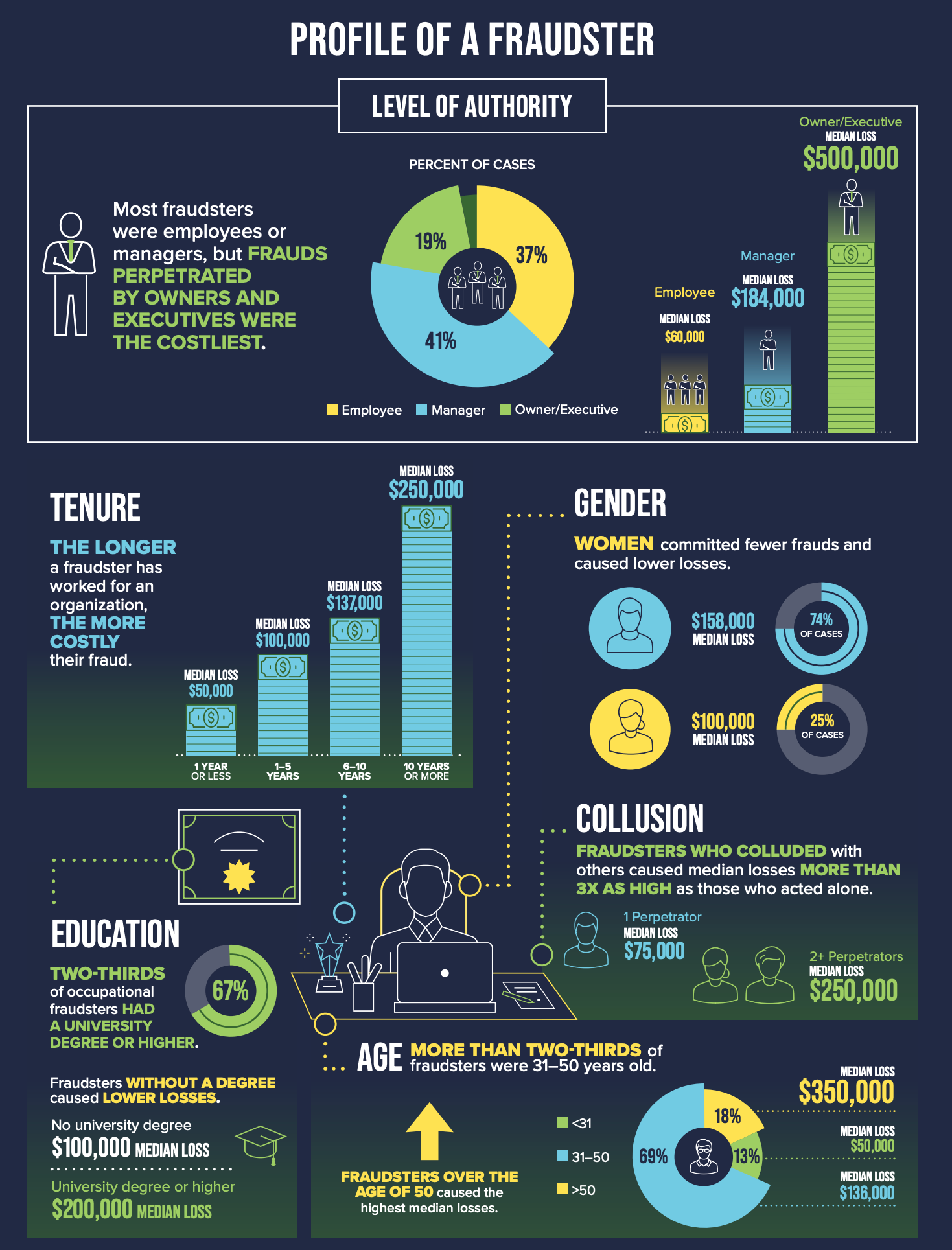2025 Financial Fraud Schemes: AI Threats, Red Flags, Forensic Consultation
Financial fraud schemes are growing at a rate we've never seen before. The latest ACFE reports show AI-driven scams now account for more than half of digital financial fraud, with deepfake videos, voice cloning, and synthetic identities becoming common tactics. Fraudsters use these methods to bypass checks, target payment systems, and create convincing fake transactions that even seasoned professionals struggle to spot.
Industries like healthcare and finance face special risks. In 2025, deposit fraud, bogus insurance claims, fake billing, and fraudulent financial statements are on the rise. Common financial fraud schemes such as phishing, embezzlement, invoice fraud, and document forgery aren't going away—they're simply becoming harder to detect as criminals adopt new technologies. Fraudsters now use “fraud-as-a-service” kits, giving even low-skilled scammers access to advanced tools and making the threat bigger for every organization.
Organizations need to address these risks with strong, up-to-date controls and a keen understanding of how fraudsters operate. Learning about evolving financial fraud schemes is the first step to protecting your resources. For those seeking a deeper understanding of red flags, see our overview on how financial statement fraud happens.
In this post, you’ll see which financial transactions and fraud schemes top the lists for 2025, explore how criminals use AI to hide their tracks, and get practical tips to safeguard your business. If you’re ready for guidance or a confidential assessment, call us or fill out our form for a forensic consultation. See how our fraud detection services could strengthen your defenses this year.
AI-Driven Financial Fraud Schemes in 2025
Fraudsters harness AI to fuel complex financial fraud schemes. Their tactics go far beyond false emails or forged documents. With tools that mimic real people and create fake identities almost instantly, bad actors target businesses of all sizes. Understanding the signs and strengthening verification processes are more critical than ever. The following sections break down two major trends shaping financial statement fraud schemes in 2025—and what organizations can do to stay ahead.
Deepfakes and Voice Scams
AI-generated deepfakes and voice cloning now create risks that weren’t even conceivable a few years ago. Scammers simulate the voices and faces of CEOs, financial officers, or vendors with shocking realism. In 2025, these forgery tactics power spear-phishing attacks and payment diversion schemes. For example, a deepfake video of a company leader can pressure a staff member to approve a wire transfer to a criminal’s account, or an altered voice message can override standard controls for releasing funds. This approach makes financial statement fraud schemes much harder to spot.
To combat this, organizations should:
- Use multifactor verification before approving high-value transactions
- Require out-of-band confirmations for payment changes or urgent requests
- Implement regular training on detecting fake audio and video
- Monitor timing and behavior patterns for outliers
Recent year-end data show that deepfake attacks and AI phishing now outpace ransomware for both frequency and losses ( statistical breakdown on deepfake phishing ). To go deeper on how technology can help organizations identify these tactics, see our take on the technology's impact on fraud detection.
Synthetic Identities in Fraud
AI allows criminals to craft credible synthetic identities by stitching together real and fabricated information from data breaches, social platforms, and public sources. These fake profiles are then used to open accounts, apply for loans, or submit invoices that appear legitimate. Nonprofits and construction firms are at particular risk; their trust-based, high-volume payment systems make them tempting targets for scammers looking to exploit gaps in financial transactions and fraud schemes. Synthetic vendors or employees may submit invoices for nonexistent goods, siphoning off funds under the radar.
Preventive best practices include:
- Tightening onboarding for new vendors and staff
- Performing thorough, ongoing background and document checks
- Leveraging real-time analytics to flag mismatched or anomalous transaction data
- Keeping records current to quickly spot fake accounts
For organizations interested in the evolution of these tactics and how the field of forensic accounting supports detection, check out our guide to the future of forensic accounting.
To protect your business from these and other common financial fraud schemes, reach out to us for a forensic consultation. Call or fill out our confidential online form for expert support.
Cryptocurrency and Digital Asset Frauds
Financial fraud schemes rapidly adapt to new technology each year, and 2025 is no different. Among the most damaging are scams that target digital assets and instant payments. These attacks are designed to exploit trust, speed, and gaps in controls, trapping organizations and their people in financial losses. The tactics outlined below have been at the forefront in 2025 and require fresh thinking when updating your fraud prevention measures.
Pig Butchering Scams
Pig butchering scams, known for their deliberate and patient manipulation, are surging in 2025. Scammers pose as trusted online contacts, using social media and messaging apps to build relationships over weeks or even months. Once trust is established, they coax victims into investing in fake cryptocurrency opportunities, often displaying fabricated dashboards and returns. Scammers sometimes hijack legitimate accounts to boost credibility, making it harder to detect fraudulent activity.
This blend of emotional manipulation, urgency, and advanced impersonation techniques means that even tech-savvy employees can become targets. Training should stress vigilance with unsolicited crypto offers, encourage a “trust but verify” approach for all investment claims, and promote the use of external confirmation channels. Employees need to understand the signs of grooming and must feel comfortable flagging suspicious contacts before any funds are moved. For a detailed breakdown and case study on these scams, review Verafin’s case on pig butchering crypto scam victims.
Fraud in Instant Payments
Instant payments make financial transactions fast, but this speed comes with added risk. In 2025, financial fraud schemes like authorized push payment (APP) fraud intensified. Here, criminals manipulate staff or clients to authorize real-time transfers, often by posing as trusted vendors or leadership. With funds moving in seconds, opportunities for reversing transactions disappear quickly, making detection critical—especially for government and manufacturing clients managing high-volume, high-value payments.
A report from Verafin forecasts inflection points for instant payment systems, underscoring the need for organizations to develop quick-response playbooks. Real-time fraud monitoring is now essential; it requires systems that flag atypical transaction behavior and cross-reference payee details instantly. Institutions that invest in data analysis tools tied to payment platforms will spot scams faster and keep losses in check. For insight into evolving fraud detection in instant payments, review Verafin’s eBook on understanding fraud schemes & scams.
For organizations worried about these common financial fraud schemes, the best step is a tailored forensic assessment. Call us or fill out our form for a confidential consultation and get practical help securing your digital payment channels.
Job Scams and Social Engineering Threats
Financial fraud schemes in 2025 target people as much as systems. Criminals lean on sophisticated social engineering, blending AI and credible impersonation to break through even strong controls. Two trends stand out: employment fraud tactics that lead to data theft or financial losses, and a new wave of business email compromise attacks fueled by automation and fraud-for-hire services. Staying ahead means knowing the warning signs and using stepwise verification—before trust is exploited and assets are lost.
Employment Fraud Tactics: Break Down of Fake Job Offers in 2025
Fake job offers remain a prime entry point for data theft, credential hacking, and wire fraud. In 2025, attackers deploy ultra-convincing career sites and fake recruiter personas to harvest personal data. They may push applicants toward bogus onboarding portals that mimic real systems, requesting sensitive details like direct deposit information, Social Security numbers, or even upfront “employment processing” fees. Once trust is gained, some schemes escalate with requests for payments to supposed vendors or urgent software purchases—money that is wired directly to criminal accounts.
Warning signs include sudden job offers without a thorough interview, requests for confidential details before any formal documentation, or communications from domains not matching company websites. Fraudsters may even use AI to scan LinkedIn for recently unemployed targets, customizing their approach for maximum credibility.
Protecting against these tactics means establishing clear verification steps:
- Check all communications for mismatched email addresses or suspicious domains.
- Verify open positions directly with HR using an official company contact.
- Delay new vendor or payment setups until multiple-step validation.
- Ensure onboarding processes never require direct payments from new hires.
Comprehensive resources, like this interview fraud prevention guide , detail current best practices for multi-stage verification and AI forgery screening. Organizations looking to layer controls can further explore proven steps on protecting your business from financial fraud to block employment scams from reaching critical systems.
Business Email Compromise Evolution: The Rise of AI and Fraud Kits
Business email compromise (BEC) attacks have grown more dangerous in 2025. What began as fake executive emails now involves AI-powered attacks that accurately mimic writing styles and company processes. Criminals purchase “fraud-as-a-service” kits, giving even less-skilled operators tools to launch convincing attacks at scale. These kits often include breached data, email templates, and automated scripts, making it easier than ever to target internal financial statement fraud schemes.
AI dynamically personalizes emails to fit company tone, mentions actual account numbers, or references recent projects. This realism means even vigilant staff can fall for urgent requests to reroute wire transfers or change vendor payment details. The speed and polish of attacks have made MFA (multi-factor authentication) an absolute requirement, not a luxury.
Key strategies to counter BEC and similar schemes:
- Require MFA for every payment workflow and email login.
- Set up multi-step approvals for financial transactions flagged as high value or out-of-pattern.
- Use out-of-band verification, such as phone calls or secure apps, for all payment or vendor changes.
- Train employees to spot subtle signs, like minor detail changes in sender addresses.
Industry insights point to the growing use of BEC within the broader trend of automated financial fraud schemes. Detailed guidance on how criminals conceal activities is available in our article on methods fraudsters use to conceal illicit finance. This can help organizations map out points of exposure and design robust checks.
Call us or fill out our form for a forensic consultation. See how our fraud detection and prevention services can fortify your defenses in this landscape of evolving threats.
Conclusion
Financial fraud schemes in 2025 set a new standard for speed and complexity. This year, criminals are turning to AI-generated deepfakes, synthetic identities, and fraud kits that target both digital assets and traditional financial processes. The result: even organizations with strong controls need better strategies to handle threats that move faster than ever before.
Modern common financial fraud schemes now touch every industry, from healthcare to government. Expertise matters. Whether you need to uncover suspicious financial statement fraud schemes, tighten controls over payment platforms, or respond to real-time attacks, industry-tested support can make the difference between loss and resilience. Our team brings you unbiased forensic skills, proven detection methods, and the ability to trace even the most concealed assets. For more on forensic accounting innovations, see our article about forensic accounting tools for valuation.
Protect what you’ve built and stay ahead of changing financial transactions and fraud schemes by tapping into specialized forensic consultation. Call us or fill out our form for a confidential assessment. Thank you for reading and trusting Turning Numbers as your partner in safeguarding your assets across industries.




